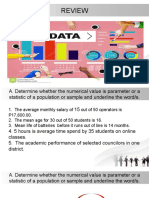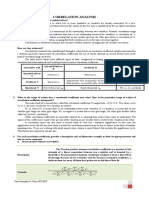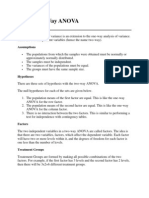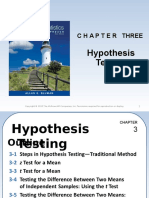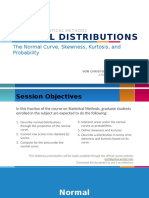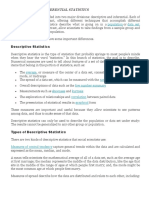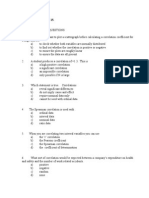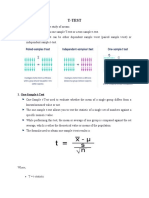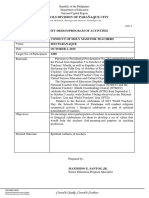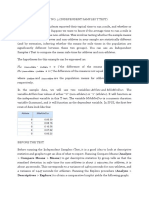0 ratings0% found this document useful (0 votes)
198 viewsT TEST Lecture
T TEST Lecture
Uploaded by
Max SantosThe Independent Samples t Test compares the means of two independent groups on a continuous dependent variable to determine if there is a statistically significant difference between the population means. It requires independent observations, random sampling, normally distributed data, homogeneity of variances between the groups, and no outliers. It is commonly used to compare the means of two groups, interventions, or change scores. Alternative tests exist for when its assumptions are violated.
Copyright:
© All Rights Reserved
Available Formats
Download as PPTX, PDF, TXT or read online from Scribd
T TEST Lecture
T TEST Lecture
Uploaded by
Max Santos0 ratings0% found this document useful (0 votes)
198 views26 pagesThe Independent Samples t Test compares the means of two independent groups on a continuous dependent variable to determine if there is a statistically significant difference between the population means. It requires independent observations, random sampling, normally distributed data, homogeneity of variances between the groups, and no outliers. It is commonly used to compare the means of two groups, interventions, or change scores. Alternative tests exist for when its assumptions are violated.
Original Title
T TEST lecture.pptx
Copyright
© © All Rights Reserved
Available Formats
PPTX, PDF, TXT or read online from Scribd
Share this document
Did you find this document useful?
Is this content inappropriate?
The Independent Samples t Test compares the means of two independent groups on a continuous dependent variable to determine if there is a statistically significant difference between the population means. It requires independent observations, random sampling, normally distributed data, homogeneity of variances between the groups, and no outliers. It is commonly used to compare the means of two groups, interventions, or change scores. Alternative tests exist for when its assumptions are violated.
Copyright:
© All Rights Reserved
Available Formats
Download as PPTX, PDF, TXT or read online from Scribd
Download as pptx, pdf, or txt
0 ratings0% found this document useful (0 votes)
198 views26 pagesT TEST Lecture
T TEST Lecture
Uploaded by
Max SantosThe Independent Samples t Test compares the means of two independent groups on a continuous dependent variable to determine if there is a statistically significant difference between the population means. It requires independent observations, random sampling, normally distributed data, homogeneity of variances between the groups, and no outliers. It is commonly used to compare the means of two groups, interventions, or change scores. Alternative tests exist for when its assumptions are violated.
Copyright:
© All Rights Reserved
Available Formats
Download as PPTX, PDF, TXT or read online from Scribd
Download as pptx, pdf, or txt
You are on page 1of 26
At a glance
Powered by AI
The key takeaways are that there are different types of t-tests including one sample t-test, paired samples t-test, and independent samples t-test. The one sample t-test compares a sample mean to a hypothesized population mean, while the paired samples t-test compares means from the same subjects across two time points. The independent samples t-test compares means between two independent groups.
The different types of t-tests are the one sample t-test, paired samples t-test, and independent samples t-test. The one sample t-test compares a sample mean to a hypothesized population mean. The paired samples t-test compares means from the same subjects across two time points. The independent samples t-test compares means between two independent groups.
The assumptions of the one sample t-test are that the test variable is continuous, scores are independent, the sample is randomly selected from the population, the distribution is approximately normal, variances are approximately equal, and there are no outliers.
T TEST
One Sample t Test
The One Sample t Test determines whether the sample mean is
statistically different from a known or hypothesized population
mean. The One Sample t Test is a parametric test.
This test is also known as:
Single Sample t Test
The variable used in this test is known as:
Test variable
In a One Sample t Test, the test variable is compared against a
"test value", which is a known or hypothesized value of the mean in
the population.
Common Uses
The One Sample t Test is commonly used to test the following:
Statistical difference between a sample mean and a known or hypothesized
value of the mean in the population.
Statistical difference between the sample mean and the sample midpoint of
the test variable.
Statistical difference between the sample mean of the test variable and
chance.
This approach involves first calculating the chance level on the test variable.
The chance level is then used as the test value against which the sample
mean of the test variable is compared.
Statistical difference between a change score and zero.
This approach involves creating a change score from two variables, and
then comparing the mean change score to zero, which will indicate
whether any change occurred between the two time points for the original
measures. If the mean change score is not significantly different from zero,
no significant change occurred.
Note:
The One Sample t Test can only compare a single
sample mean to a specified constant. It can not
compare sample means between two or more
groups. If you wish to compare the means of
multiple groups to each other, you will likely want
to run an Independent Samples t Test (to compare
the means of two groups) or a One-Way ANOVA
(to compare the means of two or more groups).
Data Requirement
1. Your data must meet the following requirements:
2. Test variable that is continuous (i.e., interval or ratio level)
3. Scores on the test variable are independent (i.e., independence of observations)
There is no relationship between scores on the test variable
Violation of this assumption will yield an inaccurate p value
4. Random sample of data from the population
5. Normal distribution (approximately) of the sample and population on the test variable
Non-normal population distributions, especially those that are thick-tailed or heavily
skewed, considerably reduce the power of the test
Among moderate or large samples, a violation of normality may still yield
accurate p values
6. Homogeneity of variances (i.e., variances approximately equal in both the sample and
population)
7. No outliers
Hypotheses
The null hypothesis (H0) and (two-tailed) alternative
hypothesis (H1) of the one sample T test can be expressed
as:
H0: µ = x ("the sample mean is equal to the [proposed]
population mean")
H1: µ ≠ x ("the sample mean is not equal to the [proposed]
population mean")
where µ is a constant proposed for the population mean
and x is the sample mean.
Test Statistics
Paired Sample t Test
The Paired Samples t Test compares two means that are from the same
individual, object, or related units. The two means typically represent two
different times (e.g., pre-test and post-test with an intervention between the two
time points) or two different but related conditions or units (e.g., left and right
ears, twins). The purpose of the test is to determine whether there is statistical
evidence that the mean difference between paired observations on a
particular outcome is significantly different from zero. The Paired Samples t Test is
a parametric test.
This test is also known as:
Dependent t Test
Paired t Test
Repeated Measures t Test
The variable used in this test is known as:
Dependent variable, or test variable (continuous), measured at two different
times or for two related conditions or units
Common Uses
The Paired Samples t Test is commonly used to test
the following:
Statistical difference between two time points
Statistical difference between two conditions
Statistical difference between two
measurements
Statistical difference between a matched pair
Note
The Paired Samples t Test can only compare the means for two (and only
two) related (paired) units on a continuous outcome that is normally
distributed. The Paired Samples t Test is not appropriate for analyses involving
the following: 1) unpaired data; 2) comparisons between more than two
units/groups; 3) a continuous outcome that is not normally distributed; and 4)
an ordinal/ranked outcome.
To compare unpaired means between two groups on a continuous
outcome that is normally distributed, choose the Independent
Samples t Test.
To compare unpaired means between more than two groups on a
continuous outcome that is normally distributed, choose ANOVA.
To compare paired means for continuous data that are not normally
distributed, choose the nonparametric Wilcoxon Signed-Ranks Test.
To compare paired means for ranked data, choose the nonparametric
Wilcoxon Signed-Ranks Test.
Data Requirement
Your data must meet the following requirements:
Dependent variable that is continuous (i.e., interval or ratio level)
Note: The paired measurements must be recorded in two separate variables.
Related samples/groups (i.e., dependent observations)
The subjects in each sample, or group, are the same. This means that the subjects
in the first group are also in the second group.
Random sample of data from the population
Normal distribution (approximately) of the difference between the paired values
No outliers in the difference between the two related groups
Note: When testing assumptions related to normality and outliers, you must use a
variable that represents the difference between the paired values - not the original
variables themselves.
Note: When one or more of the assumptions for the Paired Samples t Test are not
met, you may want to run the nonparametric Wilcoxon Signed-Ranks Test instead.
Hypotheses
The hypotheses can be expressed in two different ways that express
the same idea and are mathematically equivalent:
H0: µ1 = µ2 ("the paired population means are equal")
H1: µ1 ≠ µ2 ("the paired population means are not equal")
OR
H0: µ1 - µ2 = 0 ("the difference between the paired population
means is equal to 0")
H1: µ1 - µ2 ≠ 0 ("the difference between the paired population
means is not 0")
where
µ1 is the population mean of variable 1, and
µ2 is the population mean of variable 2.
Test Statistics
Independent Samples t Test
The Independent Samples t Test compares the means of two independent
groups in order to determine whether there is statistical evidence that the
associated population means are significantly different. The Independent
Samples t Test is a parametric test.
This test is also known as:
Independent t Test
Independent Measures t Test
Independent Two-sample t Test
Student t Test
Two-Sample t Test
Uncorrelated Scores t Test
Unpaired t Test
Unrelated t Test
Independent Samples t Test
The variables used in this test are known as:
Dependent variable, or test variable
Independent variable, or grouping variable
Common Uses
The Independent Samples t Test is commonly used to test the
following:
Statistical differences between the means of two groups
Statistical differences between the means of two interventions
Statistical differences between the means of two change scores
Note: The Independent Samples t Test can only compare the
means for two (and only two) groups. It cannot make comparisons
among more than two groups. If you wish to compare the means
across more than two groups, you will likely want to run an ANOVA.
Data Requirement
1. Your data must meet the following requirements:
2. Dependent variable that is continuous (i.e., interval or ratio level)
3. Independent variable that is categorical (i.e., two or more groups)
4. Cases that have values on both the dependent and independent variables
5. Independent samples/groups (i.e., independence of observations)
There is no relationship between the subjects in each sample. This means
that:
a. Subjects in the first group cannot also be in the second group
b. No subject in either group can influence subjects in the other group
c. No group can influence the other group
Violation of this assumption will yield an inaccurate p value
Data Requirement
5. Random sample of data from the population
6. Normal distribution (approximately) of the dependent variable for each group
Non-normal population distributions, especially those that are thick-tailed
or heavily skewed, considerably reduce the power of the test
Among moderate or large samples, a violation of normality may still yield
accurate p values
7. Homogeneity of variances (i.e., variances approximately equal across groups)
When this assumption is violated and the sample sizes for each group differ,
the p value is not trustworthy. However, the Independent Samples t Test
output also includes an approximate t statistic that is not based on
assuming equal population variances; this alternative statistic, called the
Welch tTest statistic1, may be used when equal variances among
populations cannot be assumed. The Welch t Test is also known an
Unequal Variance T Test or Separate Variances T Test.
8. No outliers
Note
When one or more of the assumptions for the Independent
Samples t Test are not met, you may want to run the nonparametric
Mann-Whitney U Test instead.
Researchers often follow several rules of thumb:
Each group should have at least 6 subjects, ideally more.
Inferences for the population will be more tenuous with too few
subjects.
Roughly balanced design (i.e., same number of subjects in each
group) are ideal. Extremely unbalanced designs increase the
possibility that violating any of the requirements/assumptions will
threaten the validity of the Independent Samples t Test.
Hypotheses
The null hypothesis (H0) and alternative hypothesis (H1) of the
Independent Samples t Test can be expressed in two different but
equivalent ways:
H0: µ1 = µ2 ("the two population means are equal")
H1: µ1 ≠ µ2 ("the two population means are not equal")
OR
H0: µ1 - µ2 = 0 ("the difference between the two population means is
equal to 0")
H1: µ1 - µ2 ≠ 0 ("the difference between the two population means is
not 0")
where µ1 and µ2 are the population means for group 1 and group 2,
respectively. Notice that the second set of hypotheses can be derived
from the first set by simply subtracting µ2 from both sides of the equation.
Levene’s Test for Equality of Variances
Recall that the Independent Samples t Test requires the assumption
of homogeneity of variance -- i.e., both groups have the same
variance. SPSS conveniently includes a test for the homogeneity of
variance, called Levene's Test, whenever you run an independent
samples T test.
The hypotheses for Levene’s test are:
H0: σ12 - σ22 = 0 ("the population variances of group 1 and 2 are
equal")
H1: σ12 - σ22 ≠ 0 ("the population variances of group 1 and 2 are
not equal")
This implies that if we reject the null hypothesis of Levene's Test, it
suggests that the variances of the two groups are not equal; i.e.,
that the homogeneity of variances assumption is violated.
Levene’s Test for Equality of Variances
The output in the Independent Samples Test table includes two
rows: Equal variances assumed and Equal variances not assumed. If
Levene’s test indicates that the variances are equal across the two
groups (i.e., p-value large), you will rely on the first row of output, Equal
variances assumed, when you look at the results for the actual
Independent Samples t Test (under t-test for Equality of Means). If
Levene’s test indicates that the variances are not equal across the two
groups (i.e., p-value small), you will need to rely on the second row of
output, Equal variances not assumed, when you look at the results of the
Independent Samples t Test (under the heading t-test for Equality of
Means).
The difference between these two rows of output lies in the way the
independent samples t test statistic is calculated. When equal variances
are assumed, the calculation uses pooled variances; when equal
variances cannot be assumed, the calculation utilizes un-pooled
variances and a correction to the degrees of freedom.
Test Statistics
Test Statistics
Reference:
Kent State University Library
https://libguides.library.kent.edu/SPSS
Thank You!
You might also like
- Summative Test - Ms PowerpointDocument4 pagesSummative Test - Ms PowerpointMax Santos100% (4)
- Summative Test - MS Word 2016Document3 pagesSummative Test - MS Word 2016Max Santos100% (2)
- Presentation T TestDocument31 pagesPresentation T TestEe HAng Yong0% (1)
- Module 8 Part 4Document10 pagesModule 8 Part 4Fatemeh YarahmadiNo ratings yet
- Three Types of ResearchDocument8 pagesThree Types of Researchasghaznavi95% (19)
- Measurement and Scaling: UNIT:03Document36 pagesMeasurement and Scaling: UNIT:03Nishant Joshi100% (1)
- Inferential StatisticsDocument57 pagesInferential StatisticsNurul Intan Fairuz100% (1)
- What Is A Weighted Average?Document12 pagesWhat Is A Weighted Average?SachinNo ratings yet
- SPSS OverviewDocument39 pagesSPSS OverviewMimo Barua100% (1)
- Proposed Committee - 1st Division Stakeholders ConvergenceDocument2 pagesProposed Committee - 1st Division Stakeholders ConvergenceMax SantosNo ratings yet
- Mental Hygiene and EducationDocument22 pagesMental Hygiene and EducationMax Santos100% (1)
- Independent Sample T-TestDocument21 pagesIndependent Sample T-TestNuray Akdemir100% (1)
- Talisayon Chapter 4 DepEdDocument13 pagesTalisayon Chapter 4 DepEdShekaina Faith Cuizon LozadaNo ratings yet
- Quasi ExperimentalDocument12 pagesQuasi ExperimentalSwan100% (1)
- Meaning and Nature of ResearchDocument11 pagesMeaning and Nature of ResearchReham Que100% (1)
- Topic 1Document37 pagesTopic 1Wafaa Adam100% (1)
- Data ManagementDocument23 pagesData ManagementMarydelle SubitoNo ratings yet
- Mixed Methods - PresentationDocument16 pagesMixed Methods - PresentationObote DanielNo ratings yet
- Hypothesis TestingDocument5 pagesHypothesis TestingRikki MeraNo ratings yet
- TOPIC 2. Sampling Techniques Methods of Data Collection and PresentationDocument32 pagesTOPIC 2. Sampling Techniques Methods of Data Collection and PresentationNicnic PonicNo ratings yet
- Item Difficulty and Item DiscriminationDocument19 pagesItem Difficulty and Item Discriminationbhagavathishree131200100% (1)
- Module 20 Inferential Statistics (Parametric Test)Document71 pagesModule 20 Inferential Statistics (Parametric Test)Niño Andrey AmboyNo ratings yet
- Correlation AnalysisDocument7 pagesCorrelation Analysisapi-339611548No ratings yet
- Stats Annova Two WayDocument4 pagesStats Annova Two WaySubhasis RahaNo ratings yet
- Chapter 3 Hypothesis Testing - Mean One SampleDocument53 pagesChapter 3 Hypothesis Testing - Mean One SamplemfyNo ratings yet
- Counterbalanced or Latin Square DesignDocument2 pagesCounterbalanced or Latin Square DesignRaymart OliverosNo ratings yet
- Basic Anova PDFDocument6 pagesBasic Anova PDFEmmanuel Jimenez-Bacud, CSE-Professional,BA-MA Pol SciNo ratings yet
- One-Way ANOVA: What Is This Test For?Document21 pagesOne-Way ANOVA: What Is This Test For?AnandyagunaNo ratings yet
- Chapter One Introduction To Research MethodologyDocument27 pagesChapter One Introduction To Research MethodologyBaruk Umeta DegoNo ratings yet
- Hypothesis Testing With T TestsDocument52 pagesHypothesis Testing With T TestsEdimar Joshua Friala100% (1)
- Sampling and Sampling DistributionsDocument78 pagesSampling and Sampling DistributionsASHISH100% (22)
- Day 2-Statistical Measures of Data RevDocument82 pagesDay 2-Statistical Measures of Data RevJulius Supe-riorNo ratings yet
- T Test ExpamlesDocument7 pagesT Test ExpamlesSaleh Muhammed BareachNo ratings yet
- MANOVADocument70 pagesMANOVAMuhammad Mehtab AbbasiNo ratings yet
- How To Write A Research ProposalDocument22 pagesHow To Write A Research ProposalNimra TariqNo ratings yet
- Theoretical and Conceptual FrameworkDocument6 pagesTheoretical and Conceptual FrameworkGround ZeroNo ratings yet
- T TestDocument25 pagesT TestTanvi Sharma67% (3)
- 04 Discrete and Continuous Random VariablesDocument29 pages04 Discrete and Continuous Random Variablesinderjeet782100% (1)
- Social InclusionDocument85 pagesSocial InclusionAashish BhandariNo ratings yet
- Measure of Central TendancyDocument27 pagesMeasure of Central TendancySadia HakimNo ratings yet
- Linear RegressionDocument28 pagesLinear RegressionHajra100% (2)
- Data AnalysisDocument15 pagesData AnalysisJordan Manlapaz100% (1)
- Basic Concepts of Quantitative ResearchDocument38 pagesBasic Concepts of Quantitative Researchpinoybsn26100% (1)
- Exploring Regression AnalysisDocument13 pagesExploring Regression AnalysisFoxiverseNo ratings yet
- Variables and Type of DataDocument20 pagesVariables and Type of DataDaia Amin100% (3)
- Normal Distributions: The Normal Curve, Skewness, Kurtosis, and ProbabilityDocument14 pagesNormal Distributions: The Normal Curve, Skewness, Kurtosis, and ProbabilityAnonymous FeGW7wGm0No ratings yet
- How To Write Chapter 3-Methods of Research and ProceduresDocument17 pagesHow To Write Chapter 3-Methods of Research and ProceduresJASTINENo ratings yet
- Activity Worksheet MVDocument5 pagesActivity Worksheet MVabdulbasit salicNo ratings yet
- Independent T-Test For Two SamplesDocument3 pagesIndependent T-Test For Two SamplesJohn ChenNo ratings yet
- Descriptive and Inferential StatisticsDocument10 pagesDescriptive and Inferential StatisticsRyan Menina100% (1)
- Central Tendency: Mode, Median, and MeanDocument15 pagesCentral Tendency: Mode, Median, and MeanKrung KrungNo ratings yet
- Research DesignDocument10 pagesResearch Designapi-3774614100% (1)
- ADVANCED STATISTICS ActivitiesDocument12 pagesADVANCED STATISTICS ActivitiesJD VeridianoNo ratings yet
- Measures of Central TendencyDocument5 pagesMeasures of Central TendencyAbigail CabisonNo ratings yet
- Basic Concepts of One Way Analysis of Variance (ANOVA)Document38 pagesBasic Concepts of One Way Analysis of Variance (ANOVA)Leomard SilverJoseph Centron LimNo ratings yet
- Unit 3. Sampling DistributionDocument10 pagesUnit 3. Sampling DistributionMildred Arellano Sebastian100% (2)
- 4-Frequency DistributionDocument33 pages4-Frequency DistributionZoren Divina BorretaNo ratings yet
- HypothesisDocument28 pagesHypothesisj tadeja100% (2)
- Chap 15 Web SiteDocument8 pagesChap 15 Web SiteSherry Phillips100% (1)
- Two-Way AnovaDocument19 pagesTwo-Way AnovaidriszakariaNo ratings yet
- Statistical TreatmentDocument1 pageStatistical Treatmentmonico39No ratings yet
- Week 5, Unit 2 Quantitative and Qualitative Data AnalysisDocument54 pagesWeek 5, Unit 2 Quantitative and Qualitative Data AnalysisKevin Davis100% (1)
- T-Test MaterialDocument10 pagesT-Test Materialhakimnguyen08No ratings yet
- T-Test (Independent & Paired) 1Document7 pagesT-Test (Independent & Paired) 1መለክ ሓራNo ratings yet
- Letter RequestDocument1 pageLetter RequestMax SantosNo ratings yet
- LS 6 - Summative Test No. 4Document3 pagesLS 6 - Summative Test No. 4Max SantosNo ratings yet
- Oath of Office - FptaDocument2 pagesOath of Office - FptaMax SantosNo ratings yet
- Summative - MS WordDocument3 pagesSummative - MS WordMax SantosNo ratings yet
- Oath of Office - SptaDocument1 pageOath of Office - SptaMax Santos100% (5)
- LS 6 - Computer Concepts (Parts of Computer)Document2 pagesLS 6 - Computer Concepts (Parts of Computer)Max Santos100% (1)
- Summative Test - Ms ExcelDocument3 pagesSummative Test - Ms ExcelMax SantosNo ratings yet
- Learning Strand 6 - Most Essential CompetenciesDocument2 pagesLearning Strand 6 - Most Essential CompetenciesMax SantosNo ratings yet
- Baclaran Elementary School CentralDocument3 pagesBaclaran Elementary School CentralMax SantosNo ratings yet
- ACTIVITY PROPOSAL - Conduct of Holy Mass For TeachersDocument5 pagesACTIVITY PROPOSAL - Conduct of Holy Mass For TeachersMax Santos100% (1)
- Division Letter - Second National Convention and SeminarDocument1 pageDivision Letter - Second National Convention and SeminarMax SantosNo ratings yet
- Certificate-Of-Recognition-Barangay CaptainsDocument15 pagesCertificate-Of-Recognition-Barangay CaptainsMax Santos50% (2)
- Expected Output For Events Management NC IIIDocument2 pagesExpected Output For Events Management NC IIIMax SantosNo ratings yet
- Summative - MS WordDocument3 pagesSummative - MS WordMax SantosNo ratings yet
- SOARDocument6 pagesSOARMax SantosNo ratings yet
- Independent Samples T Test - Activity SheetDocument4 pagesIndependent Samples T Test - Activity SheetMax SantosNo ratings yet
- The Role of Women in Technology EducationDocument31 pagesThe Role of Women in Technology EducationMax SantosNo ratings yet
- Independent Samples T Test (LECTURE)Document10 pagesIndependent Samples T Test (LECTURE)Max SantosNo ratings yet
- Paired Samples T Test - Activity SheetDocument3 pagesPaired Samples T Test - Activity SheetMax Santos100% (1)
- Sdo - Sgod - SMN - Pdo2Document2 pagesSdo - Sgod - SMN - Pdo2Max SantosNo ratings yet
- BE Forms-Consolidated-division and SchoolDocument4 pagesBE Forms-Consolidated-division and SchoolMax SantosNo ratings yet
- Statement of Interest (SOI)Document1 pageStatement of Interest (SOI)Max Santos100% (1)
- Patna University: Courses of Study For M.A./M.Sc. (STATISICS)Document24 pagesPatna University: Courses of Study For M.A./M.Sc. (STATISICS)sam streetNo ratings yet
- Chapter 4 Environmental Scanning and Industry Analysis: Strategic Management & Business Policy, 13e (Wheelen/Hunger)Document25 pagesChapter 4 Environmental Scanning and Industry Analysis: Strategic Management & Business Policy, 13e (Wheelen/Hunger)Bayan HasanNo ratings yet
- SyllabusDocument1 pageSyllabusugurum668No ratings yet
- Aircraft Design Project Designing A Competitor Fighter AircraftDocument45 pagesAircraft Design Project Designing A Competitor Fighter AircraftKarthick. GNo ratings yet
- Nios Math 2018Document9 pagesNios Math 2018Vineet KumarNo ratings yet
- Udacity Business Analyst Project 8Document19 pagesUdacity Business Analyst Project 8yogafireNo ratings yet
- Truss Lecture (1) - Mechanics of MaterialsDocument46 pagesTruss Lecture (1) - Mechanics of MaterialsMichael ChavezNo ratings yet
- 2 Mean Median Mode VarianceDocument29 pages2 Mean Median Mode VarianceBonita Mdoda-ArmstrongNo ratings yet
- Boundedness Conditions of Hausdorff H-Measure in Metric SpacesDocument8 pagesBoundedness Conditions of Hausdorff H-Measure in Metric Spacesmoustafa.mehanna7564No ratings yet
- Module 5 Learning NotesDocument5 pagesModule 5 Learning Notessamwel kiwaleNo ratings yet
- Lecture 4 Data Analysis Summary Measures 1Document24 pagesLecture 4 Data Analysis Summary Measures 1Keaobaka TlagaeNo ratings yet
- Concept ChecklistDocument4 pagesConcept Checklistapi-317922107100% (1)
- Opti ControlDocument4 pagesOpti ControlMithun John100% (2)
- On Some Optimal Control Problems For Electric CircuitsDocument21 pagesOn Some Optimal Control Problems For Electric CircuitsJaime Alberto Parra PlazasNo ratings yet
- Calculus II Volumes: Cory Robinson & Blake Moyer With Advisor Jeremy Becnel, PH.DDocument1 pageCalculus II Volumes: Cory Robinson & Blake Moyer With Advisor Jeremy Becnel, PH.DBernie Calderon MagtalasNo ratings yet
- Acuan Metode Kalibrasi PH Meter-AGAL W PDFDocument7 pagesAcuan Metode Kalibrasi PH Meter-AGAL W PDFjepri purwantoNo ratings yet
- Manifold: Differentiable Manifolds and If Differentiation Can Take Place Arbitrarily Often They AreDocument1 pageManifold: Differentiable Manifolds and If Differentiation Can Take Place Arbitrarily Often They AreevilmonsterbeastNo ratings yet
- Integrals - Math148Document20 pagesIntegrals - Math148nkmarshNo ratings yet
- Industrial Engineering LabDocument20 pagesIndustrial Engineering Labajainb239No ratings yet
- A Review On Method Development, Validation, Optimization and Applications of HPLCDocument10 pagesA Review On Method Development, Validation, Optimization and Applications of HPLCIJRASETPublicationsNo ratings yet
- DiscourseDocument45 pagesDiscoursechestnutofficial2020No ratings yet
- Gauss TestDocument10 pagesGauss TestpudintekelNo ratings yet
- Basic Calculus THE FUNDAMENTAL THEOREM OF CALCULUSDocument6 pagesBasic Calculus THE FUNDAMENTAL THEOREM OF CALCULUSJeanny Mae PesebreNo ratings yet
- Application of Definite IntegralDocument15 pagesApplication of Definite IntegralKirkD'costaNo ratings yet
- Using Excel Solver in Optimization Problems: November 2014Document9 pagesUsing Excel Solver in Optimization Problems: November 2014Chandrabali SahaNo ratings yet
- An Introduction To Elliptic Curves and Modular FormsDocument19 pagesAn Introduction To Elliptic Curves and Modular FormsJhon Edison Bravo BuitragoNo ratings yet
- Numerical Solution of Fluid Flow: Nguyen Quang KhaiDocument7 pagesNumerical Solution of Fluid Flow: Nguyen Quang KhaiKhai NguyenNo ratings yet
- Edexcel GCE: Calculators May NOT Be Used For These QuestionsDocument35 pagesEdexcel GCE: Calculators May NOT Be Used For These QuestionsМаша ЛысенкоNo ratings yet
- Intro To Public Policy and AdministrationDocument1 pageIntro To Public Policy and AdministrationWhitelady LonNo ratings yet



















